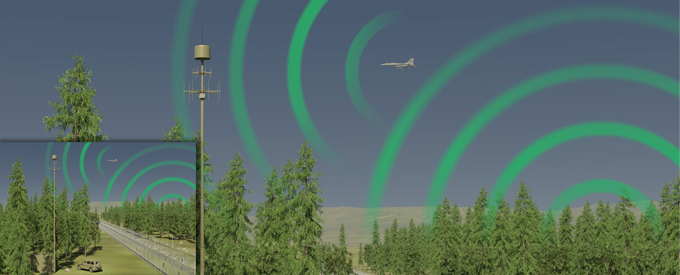2023-05-11
HENSOLDT’s Twinvis Passive Radar System - Silent surveillance of silent targets
In a warfare environment, active radars are vulnerable to being detected and their transmissions used to establish their location. Twinvis uses passive radar technology and consequently does not emit any signals of its own. This offers the opportunity for covert surveillance and makes it difficult for the enemy to detect where the system is located. ESM equipment cannot detect Twinvis thereby enabling the safe creation of a 3D air picture in a hostile environment. This is achieved with a single, silent antenna.
The wideband nature of the technology makes jamming difficult. In addition, the absence of a transmission expanding with distance means that, unlike conventional radars, the bearing and height accuracy can be maintained independently of the target distance from the antenna. This accuracy is complemented with a refresh rate several times faster than conventional air surveillance radars and equivalent to an antenna rotating at about 120 rpm.
The system works by detecting disturbances to existing transmissions from TV and radio broadcasts. This approach not only enables transmission-free 3D air situational awareness but also counters stealth aircraft design as the geometry used to avoid returning signals to their source is rendered redundant. In addition, the frequencies Twinvis uses are not in the normal radar bands thereby countering the effects of radar absorbent material (RAM).
Twinvis has significant advantages over other passive systems. There is no need for the target to be transmitting and there is no need for multiple antennas to triangulate detections to achieve a target’s position. However, adding additional antennas will increase the coverage and accuracy.
There are multiple applications for Twinvis, ranging from air surveillance in city centres, where powerful active transmissions may be undesirable, to Ground Based Air Surveillance systems or even as back up to Air Traffic Control radars.
The absence of large energy transmissions normally associated with air surveillance radars provides for a cost-effective solution with significantly lower power requirements. This in turn lends itself to mobile configurations and Twinvis can be unobtrusively integrated into a small van or off-road vehicle,
In summary, Twinvis encapsulates a ground-breaking capability that is not only transforming the battlefield but also enables air surveillance to be deployed quickly and silently wherever it is needed.
Visitors Comments
Related Topics
UAE Minister of State for Defence Affairs meets with several guests at IDEX 2021
Read More
Italian Air Force Eurofighter Typhoons Seen at Red Flag
Read More
UAE participates in GCC Joint Defence Council meeting in Muscat
Read More
Rheinmetall to Supply Skyranger Air Defence System to Austria
Read More
Embraer and Brazilian Army Sign Contract for Additional Radars
Read More
Exelis to Provide Airfield Monitoring Solutions to LA International Airport
Read More


No Comments